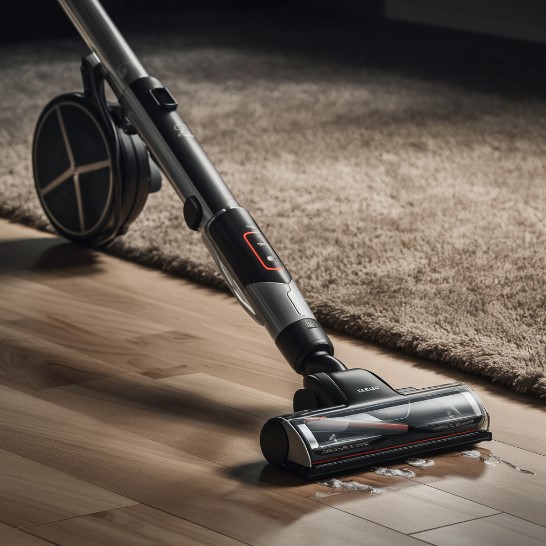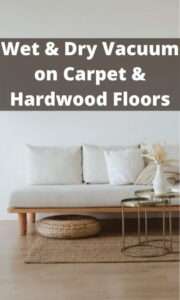
In today’s guide, we explore the versatility of wet and dry vacuums for both carpet and hardwood floors. Whether tackling spills or routine cleaning, these powerful tools offer convenience and efficiency. Discover how to choose the best vacuum for your needs and learn expert tips on maximizing its performance. Keep your floors pristine with our comprehensive advice!
In this post we will cover:
- How to Use a Wet & Dry Vacuum
- Is it worth buying a wet/dry vacuum?
- How long does it take for carpets to dry?
- Are wet and dry vacuums safe for hardwood floors?
How to Use a Wet & Dry Vacuum to Clean Carpet & Hard Floors
Carpet
Carpet cleaning has its own concerns in comparison to cleaning other surfaces. The surface easily holds on to stains, mildew, bacteria, and soil, but the task is more manageable when using a wet and dry vacuum cleaner.
The machine has unique features and washing capabilities that enable it to pick up spills, dust, dirt, and cleaning solutions from your carpet. The vacuum has powerful suction that makes cleaning up large messes effective and easy.
This is how you clean your carpet with a wet and dry vacuum cleaner:
Step 1: Before you start cleaning the carpet, prepare the room first by ensuring that the room is dry to avoid making messes when vacuuming. Also remove anything in your path that may cause obstruction, such as furniture, to expose hidden areas that need cleaning.
Step 2: Now begin cleaning the carpet by removing the surface dirt and stains from the carpet to make the vacuuming manageable. Then plug in your wet and dry vacuum and set it to dry mode to dust up and remove debris from your carpet.
Step 3: at this point apply the cleaning solution on the stained spots after dampening the carpet stains with a spray tool or a handful of water. Use a detergent that is carpet safe and ensure that you read the instructions on it.
Step 4: this is where you scrub your carpet using a clean rug or a normal scrubbing brush. The scrubbing will loosen the stains on the carpet. While scrubbing put more effort on soiled areas to pave way for extra scrubbing by the wet and dry vacuum cleaner.
Step 5: plug the wet and dry vacuum into an outlet that is close to the stained area on the carpet. Attach the required floor attachment and set the machine to start with powerful suction.
Move the head of the floor attachment over the carpet and then vacuum the water and the cleaning solution off the wet spot.
Step 6: repeat the procedure as often as necessary until the stain is completely removed. Some areas of the carpet may require more time to dry out, but you can speed up the drying process by putting the carpet in direct sunlight or under a fan.
Some tricks and tips: do not allow the carpet cleaning solution to become too concentrated while making it as it will come off too quickly. However, if it becomes concentrated, add water.
When cleaning a synthetic carpet, you can apply a tablespoon of household ammonia or a homemade vinegar solution as an alternative to detergents.
Go through the manual of your wet and dry vacuum to ensure that you have installed the correct filters on the machine.
Work in small sections while cleaning the carpet to make the cleaning thorough and effective. Ensure that an area is thoroughly dried before moving on to the next.
Hardwood floors
Hardwood floors need special attention, and using a good vacuum cleaner to clean them is essential. When it comes to hardwood, choose a vacuum cleaner with the option to switch between carpet and hardwood brushes or the ability to shut off the brush roll.
A wet and dry vacuum cleaner can easily clean hardwood floors since it has both wet and dry vacuum features for eliminating both wet and dry spills simultaneously.
When using the vacuum on hard floors, utilize the wet feature for damp or liquid spills and the dry one for dry debris, dust, or pet hair. There is no need to worry about water damaging your floor since it will be cleaned up by the dry mop on the vacuum.
FAQs
Is it worth buying a wet/dry vacuum?
Discover the versatility of wet and dry vacuum cleaners, ideal for noise-sensitive environments with advanced noise reduction technology. These vacuums handle any surface, from marble to wood, leaving no marks.
Featuring lightweight models for easy maneuvering and options for both corded reliability and cordless convenience, they offer self-cleaning systems and dual tanks for efficient maintenance.
How long does it take for carpets to dry?
To ensure your carpet dries efficiently after cleaning, allow six to twelve hours depending on conditions. Optimize drying by increasing air circulation: use ceiling fans or oscillating fans, open windows on warm, dry days, or run a dehumidifier to reduce humidity. Avoid walking on damp carpet to prevent stains and damage.
Are wet and dry vacuums safe for hardwood floors?
Wet and dry vacuums offer efficient cleaning for hardwood floors by simultaneously vacuuming and mopping, enhancing their appearance swiftly. These machines are designed to prevent excessive water use, ensuring the safety of hardwood surfaces. Ideal for diverse needs, they provide a quick and effective solution for maintaining pristine hardwood floors.
The Wind-Up
Mastering the art of cleaning with a wet & dry vacuum simplifies home maintenance. From spilled drinks on carpets to sawdust on hardwood, these versatile tools handle it all. Remember, proper attachments and techniques ensure effective results without damaging surfaces.
So, whether you’re tackling everyday messes or deep cleaning projects, a wet & dry vacuum proves indispensable in keeping your home fresh and pristine. Happy cleaning!
